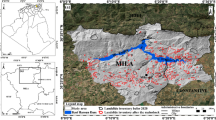Abstract
To study the ground motion levelassociated with historical earthquakeslocated in Southern Spain, we have chosen ascenario placed in the Poniente Almeriense(Southeast Spain). In this zone, somerelevant historical earthquakes haveoccurred, such as those of 1522, 1804 and1910. In particular, the earthquakes of 1804 and 1910 the estimated and calculatedmagnitudes are of M = 6.3. Those earthquakestook place near the epicentral zone of aseismic series happened in 1993–94. As partof this series, two earthquakes with M∼5were recorded by strong ground motioninstruments on 23rd December 1993, and 4th January, 1994 at Adra, Almeríaand Motril. We have used the accelerationrecords as empirical Green functions inorder to simulate the expected groundmotion associated with a hypotheticalearthquake of magnitude M = 6.3 like those of1804 and 1910. The simulations have beencarried out for three sites (Almería,Adra and Motril) using three differentapproaches. A total of 30 simulations, foreach approach, have been carried out foreach ground motion component in each site.The peak ground acceleration (PGA) and theresponse spectra are compared with thevalues obtained through empiricalrelationships for the distances and soilconditions corresponding to the threechosen sites. The results of thesimulations show that the horizontal PGAcould exceed the values observed in23/XII/93 and 4/I/94 by a factor of 5–8,surpassing in some cases the value of 140gals. Besides, some of the peak spectralaccelerations simulated reach Samax =400 gals, Adra being the location where thehighest values of amax andSamax are reached, due to the nearnessof this station to the epicentres of 23/XII/93 and 4/I/94. At Almeria, the PGAvalues reach 40 gals, which may beconsidered as input in the bedrock. InMotril, the PGA surpass a value of 130gals, considering as due to a strong localsite effect. Finally, the peak groundacceleration (PGA) and the response spectraobtained with the simulations have beencompared with other values estimated through empirical relationships for similarconditions. The conclusions about theexpected ground motion levels have animportant application aimed at the revisionof the maximum acceleration and responsespectra of the Spanish building Code,NCSE-94.
Similar content being viewed by others
References
Ambraseys, N.N., Simpson, K.A. and Bommer, J.J., 1996, Prediction of horizontal response spectra in Europe, Earth. Enging. & Struct. Dyn. 25, 371–400.
Anderson, J.G. and Hough, S.E. 1984, A model for the shape of the Fourier amplitude spectrum of acceleration at high frequencies. Bull. Seism. Soc. Am. 74, 1969–1993.
Brune, J.N., 1970, Tectonic stress and the spectra of seismic shear waves from earthquakes, J. Geophys. Res. 75, 4997–5009.
Cornell, C.A., 1968, Engineering seismic risk analisys, Bull. Seism. Soc. Am. 58, 1583–1606.
Dahle, A., Bungum, H. and Kvamme, L.F., 1990, Attenuation models inferred from intraplate earthquake recording, Earth. Enging. & Struct. Dyn. 2, 1125–1141.
Hartzell, S., 1978, Earthquake aftershocks as Green's functions, Geophys. Res. Lett. 5, 1–4.
Hartzell, S., Harmsen, S., Frankel, A. and Larsen, S., 1999, Calculation of Broadband time histories of ground motion: comparison of methods and validation using strong-ground motion from the 1994 Northridge earthquake, Bull. Seism. Soc. Am. 89, 1484–1504.
Hutchings, L., 1994, Kinematic earthquake models ad synthesized ground motion using empirical Green's functions, Bull. Seismol. Soc. Am. 84, 1028–1050.
Ibañez, J.M., 1990, Atenuacion de ondas coda and Lg en el sur de España e Italia a partir de sismogramas digitales, PhD. Thesis. Univ. Granada, 220 pp.
Ibáñez, J.M., Bottari, C., Esquivel, J.A., Morales, J. and Alguacil, G., 2001, Magnitude-intensity relations for instrumental and historical (IX-XIX century) earthquakes in south Spain. Tectonical and seismic hazard implications, Bull. Seism. Soc. Am. (submitted).
Irikura, K., 1983, Semi-empirical estimation of strong ground motions during large earthquakes, Bull. Disastt. Prev. Res. Inst., Kyoto Univ. 33, 63–104.
Jarpe, S.P. and Kasemayer, P.W., 1996, Validation of a procedure for calculating broadband strong ground-motion time histories with emprical Green's functions, Bull. Seism. Soc. Am. 86, 1116–1129.
Karnik, 1969, Seismicity of the European Area. Part. I. Reidel Pub. Co.
Martínez Solares, J.M. and Pacual Santamaría, G., 1996, Efectos de los terremotos de Almería de 1993–1994. In: Avances en Geofísica y Geodesia, Instituto Geográfico Nacional, Ministerio de Obras PÚblicas, Transporte and Medio Ambiente and el Centro Nacional de Información Geográdica. vol I, pp. 85–89.
McGuire, R.K., 1976, EQRISK. Evaluation of earthquake risk to site. USGS Open file report 76–67, 90 pp.
NCSE-94, 1994, Norma de la Construcción Sismorresistente Española BOE nÚm 33, miércoles 8 de Febrero de 1995, pp. 3935–3980.
Ordaz, M., Arboleda, J. and Singh, S.K., 1995, A scheme of random summation of an empirical Green's functions to estimate gruound motions from future large earthquakes, Bull. Seismol. Soc. Am. 85, 1635–1647.
Sabetta, F. and Pugliese, A., 1996, Estimation of response spectra and simulation of nonstationary earthquake ground motions. Bull. Seism. Soc. Am. 86, 337–352.
Singh, S.K., Aspel, R., Fried, J. and Brune, J., 1982, Spectral attenuation of SH waves along the Imperial fault, Bull. Seism. Soc. Am. 72, 2003–2016.
Singh, S.K., Pacheco, J., Courboulex, F. and Novelo, D.A., 1997. Source parameters of the Pinotepa Nacional, Mexico, earthquake of 27 March, 1996 (Mw =5.4) estimated from near-field recordings of a single station, J. Seismology 1, 39–45.
Tento, A.L., Franceschina, L. and Marcellini, A., 1992, Expected ground motion evaluation for Italian Sites. Pro. 10th World Conference on Earthquake Engineering, 1, pp. 489–494.
Turmarkin, A.G., Archuleta, R.J. and Madariaga, R., 1994, Scaling relations for composite earthquake models, Bull. Seism. Soc. Am. 84, 1279–1283.
Vidal, F., 1986, Sismotectónica de la región Bética-Mar de Alborán. PhD-Thesis Univ. Granada, 450 pp.
Wennerberg, L., 1990, Stochastic summation of empirical functions, Bull. Seismol. Soc. Am. 80, 1418–1432.
Zeng, Y., Anderson, J.G. and Yu, G., 1994, A composite source model for computing syntethics strong ground motions, Geophys. Res Lett. 21, 725–728.
Author information
Authors and Affiliations
Rights and permissions
About this article
Cite this article
Morales, J., Benito, B. & Luján, M. Expected ground motion in the south-east of Spain due to an earthquake in the epicentral area of the 1910 Adra earthquake. Journal of Seismology 7, 175–192 (2003). https://doi.org/10.1023/A:1023506015307
Issue Date:
DOI: https://doi.org/10.1023/A:1023506015307




